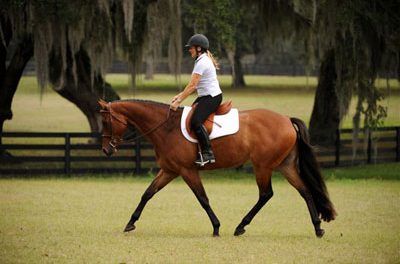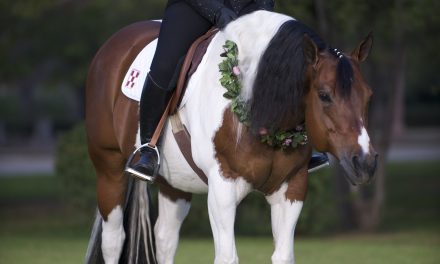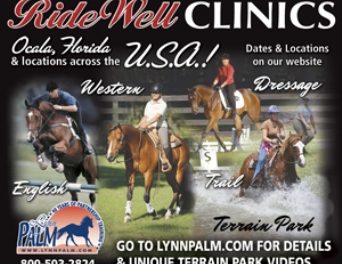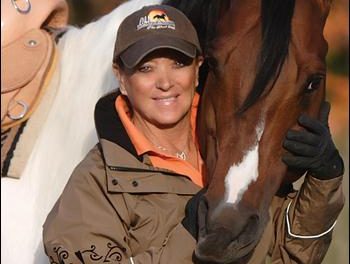Palm Partnership Training™
Building a Partnership with your Horse
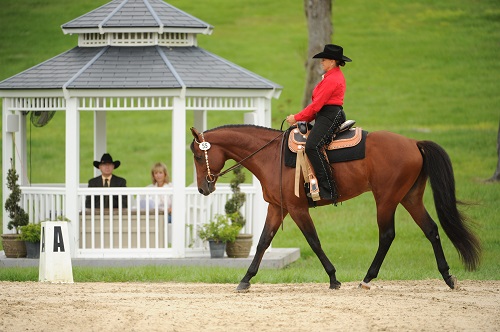
Keep your Western Dressage horse in top health by paying close daily attention. “An ounce of prevention is worth a pound of cure.” That old saying especially applies to your horse’s health and safety. You can head off many potential problems—or catch them early—by doing a daily wellness check. When you do a daily check, you can often catch the “little things” before they turn into serious, expensive issues.
The best time to do a daily check is when you feed your horse or clean his stall. If you someone else is feeding your horse, such as a barn manager, then that person needs to do the check for you. Another good time to do a check is before you turn him out, when you groom him, saddle to ride or take him out for a graze on the longe line.
Daily Horse Check
You’ll want to check your horse’s entire body during your daily check. Below I’ve commented on specific areas of the horse’s body that are easy to “miss” if you don’t make a specific effort to check carefully. If you check your horse in the same manner every time, you’ll always be sure to cover evaluating the entire horse. I suggest doing the check from “front to back and top to bottom.”
If your horse has a longer hair coat you’ll need to take your hands and feel through the hair down to the skin in all areas of longer hair growth to detect any swellings, lumps, scrapes, etc. while you’re doing your check.
Head
If your horse has a face scrape that you’ve treated for a couple of days that you find he’s rubbing the scrape and opening the wound more, your horse may have a fungal infection that’s causing him to rub. Consult your veterinarian at this point. He may direct you to wash the scrape with an antifungal shampoo on a daily basis before you apply a topical treatment to the scrape.
Under jaw
Take your hand and palpate under the horse’s jaw for any heat, lumps, swellings, cuts, etc.
Poll
During your grooming session, take your hand and feel for any bumps, swellings, or cuts in the poll area. Ask your horse to lower his head so you can check his poll. I know it’s easy when you have a tall horse that isn’t fond of putting his head down to skip checking the poll during your daily grooming. If that’s a challenge you have with your horse, you’ll absolutely want to work with him so that he lowers his head at your request.
Bottom “v” of ear, inside ear, and ear’s back
Again, take your hand and gently feel the bottom “v” of the ear and inside the ear for any cuts, bumps, swellings, etc.
Neck crest
Feel along the entire neck where the mane grows out from the neck. Part the mane so you can feel all the way down to the base of the neck for any cuts, lumps, swelling, scabs, etc.
Tail bone
Stand to the side of your horse and close to your horse at either side of the hip. Using your peripheral vision watch your horses ears as you gently take your hand and palpate the entire tail bone. Check for any swelling, cuts, scabs, bumps, etc. “Listen” to your horse for him to “tell” you with his tail, ears, or body movement that something is “not right” as you palpate his tail bone.
Stomach – midline
You’ll need to again “listen” to your horse as you take your hand and palpate the horse’s “middle” or stomach area checking for any lumps, bumps, crusts, cuts, etc. A flashlight is helpful for checking this area too if you’re in a dimly lit location. Horses on pasture may get small cuts or skin scrapes from burrs or thistles getting stuck to the skin in this area. If the cuts and scrapes are not attended to (whatever the original cause) there’s a chance the skin can get infected and need treatment.
Sheath or udder area
Check for swellings, cuts, etc. On mares you’ll want to periodically check for a gummy substance called “smegma” that builds up between the mare’s teats. (Geldings and stallions accumulate smegma in their sheath area and will need to be checked as well.) Be VERY careful when examining mares in this area and if you are uncomfortable checking your mare, get qualified help. Mares, geldings, and stallions will often rub their tails to “tell” you that the smegma build up is irritating them.
Hock
Check for puffiness/sponginess/heat in front and back of the hock.
Tendons and ligaments along cannon bones
Use your hands to palpate the horse’s ligaments and tendons from the knee down on the front legs and the hock down on the hind legs. Check for any heat, swelling, cuts, etc. Know what is “normal” for your horse.
Coronet band
Crouch down and to the side of your horse as you take your hand and feel around the entire coronet band. If you have a horse that has “feathers” such as a Clydesdale or excess hair around the coronet band you’ll need to be especially careful to feel the actual skin surface to note any bumps, cuts, scrapes, swellings, etc. Be sure to feel in the “seam” area when the coronet band meets the hoof as often times cuts can go undetected in that area.
Heel bulbs
Look and feel for any redness, swelling, bleeding, crustiness, etc. in the heel bulb area. A condition called “scratches” can develop in this area so you’ll want to especially make sure to check the heel bulbs.
Hooves
Checking your horse’s hooves every day is important for his safety and long term health. If your horse has shoes, check for any loose or sprung clinches. When you look at the bottom of the horse’s hoof, check to make sure the shoe fits securely to the hoof. If it’s loose, call your farrier ASAP. He may need to remove the shoe, and tack it back on securely to the hoof.
Pick each hoof carefully to remove any mud, pebbles, and debris. If your horse is wearing pads, remove any packed dirt, mud, etc. that may be stuck to the pads. Check for any offensive smells they may come from your horse’s hooves. If you encounter a strong odor you may need to treat the hooves for thrush.
By doing a daily check of your horse’s body you’ll be able to address many situations needing first aid. To properly care for cuts, scrapes, swellings, etc. as a result of your daily check or accidents that may happen at your barn (both horse and human) you’ll want to have a fully stocked equine and human first aid kit (I use and recommend EquiMedic products) at your barn at all times. It’s one of the best insurance policies you can buy for your horse and you! You’ll have confidence and peace of mind in knowing that you’ll be able to address minor first aid challenges and be able to give your horse help before the vet arrives or before your horse is trailered to the vet.
If you like more information related to doing a daily check of your horse, you’ll enjoy our DVD, “Grooming to Gain Your Horse’s Trust & Love.” Find this, along with many other helpful training materials, at www.lynnpalm.com, or by calling 800-503-2824.

